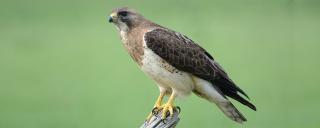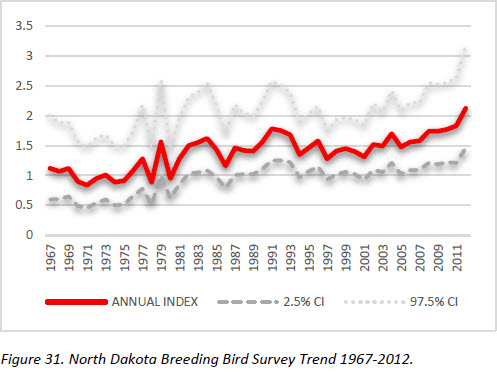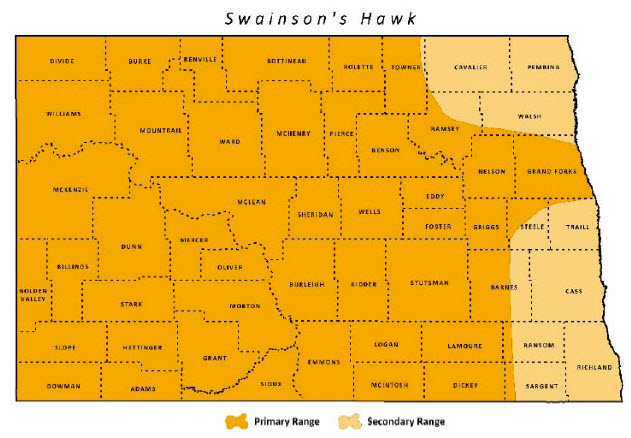

Swainson's Hawk
| Scientific Name | Buteo swainsoni |
|---|---|
| General Description | L 19”, WS 51”, 1.9 lb. A large hawk with variable plumage. Most sport a white face and a dark brown “bib.” |
| Status | Occurs in North Dakota from April to September. Peak breeding season occurs from mid-May to late July. |
| Abundance | Common. |
| Primary Habitat | Mix of grassland and cropland with thickets of trees. |
| Federal Status | Migratory Bird. |
| Reason for Designation | Reduced in relative abundance compared to 1800’s. It is included on the National USFWS Birds of Conservation Concern list, and also in Region 6 and BCR 11. |
Locations and Conditions of Key Habitat
Preferred Habitat
Swainson’s Hawks are frequently associated with open grasslands interspersed with scattered trees or shrubs. Uses shortgrass, mixed-grass, tallgrass prairie, riparian areas, isolated trees, shelterbelts, pasture, hayland, cropland, and wetland borders. Most often nest in trees and shrubs that are isolated, clumped, or in a shelterbelt but will occasionally nest on the ground. Primary prey includes small mammals, Richardson’s ground squirrels, blacktailed prairie dogs, and insects such as grasshoppers and dragonflies, particularly during migration and on wintering grounds of South America.
Key Areas and Conditions for Swainson's Hawk in North Dakota
Fairly common throughout much of North Dakota except for the Red River Valley.
Problems Which May Affect this Species
Habitat
Human activities since settlement may have increased the availability of nest sites in some areas, e.g. planting shelterbelts. However, the destruction of native prairie could affect Richardson’s ground squirrel population in North Dakota, resulting in decreased food availability for Swainson’s Hawks.
Other Natural or Manmade Factors
Nest disturbance, depending on timing during incubation, may result in desertion. Nests near roads or land easily accessed by people are less successful than nests away from well-traveled areas. Pesticide contamination does not appear to be a noteworthy factor for reduced nest production from eggshell thinning. Swainson’s Hawks are sometimes shot by humans who consider them a pest, or fear they are preying upon game birds. Some mortality from collisions with power lines, wind turbines, vehicles, or electrocution, or getting caught in fences.
Research and Survey Efforts
Current Research or Surveys
- South Dakota State University (ND SWG T-36-R) is determining breeding ecology of Swainson’s Hawks in south-central North Dakota (Grovenburg 2015).
Previous Research or Surveys
- University of Oklahoma (ND SWG T-30-R) documented breeding ecology of hawks in relation to energy extraction activities in western North Dakota. The project was initiated in 2011 and a final report was provided in 2012. Nest success for Swainson’s Hawks was relatively high, 78% (Wiggins et al. 2012).
- St. Cloud State University (ND SWG T-30-R) documented basic aspects of Swainson’s Hawk ecology in North Dakota. The project was initiated in 2004 and a final report/thesis was provided in 2006. Swainson’s Hawks were detected with increasing planted grassland and decreasing woodland cover (McCarthy 2006).
- Gilmer and Stewart (1984) studied Swainson’s Hawk nesting ecology in North Dakota from 1977 to 1979. Of the 270 occupied nest sites visited, most (43%) were in shelterbelts. Cottonwood trees were the most frequently used (44%) nesting tree. Wind and hail accounted for nearly 1/3 of the nest failures. Northern pocket gophers (Thomomys talpoides) were the most common prey. Nest success was 64% and mean number of young fledged per nest was 1.5.
- Numerous published reports and gray literature on this species throughout its range.
Additional Research or Surveys Needed
- Investigate why populations and productivity continues to decline although suitable habitat remains intact or unoccupied.
- Ecology during migration is unknown.
Population and Trend Estimates

- PIF Global Population Estimate: 580,000
- PIF North American Population Estimate: 540,000
- PIF North Dakota Population Estimate: 30,000
- North Dakota BBS Trend: see figure 31
- Survey-wide BBS Trend 1966-2012: 0.75
Management Recommendations
- Protect large tracts of native prairie or grassland.
- Protect existing stands of trees identified as important to Swainson’s Hawks, particularly known nesting sites.
- Do not disturb nests from 1 April to 1 August.
- When converting tree communities to grassland, leave a few individual trees or mosaic of trees.
- Utility development should follow the guidance of “Suggested Practices for Avian Protection on Power Lines: The State of the Art in 2006” and “Reducing Avian Collisions with Power Lines” including marking power lines and creating an Avian Protection Plan.
- Wind industry companies should collaborate with the American Wind and Wildlife Institute for responsible wind development.
Monitoring Plans
According to the Partners in Flight Landbird Conservation Plan, long-term population trend monitoring such as the Breeding Bird Survey is generally considered adequate, but some issues may not have been accounted for (e.g. bias). Monitoring plans should follow recommendations of the North American Bird Conservation Initiative ‘Opportunities for Improving Avian Monitoring’.
2005-2015 Progress
The Swainson’s Hawk remains a Level I Species of Conservation Priority. Several State Wildlife Grant Projects (T2-11-HM, T-18-R, T-20-D, T-21-D, T-22-HM, T-23-HM, T-25-HM, T-28-L, T-37-D) have contributed to habitat enhancement grasslands for Swainson’s Hawk and other grassland dependent birds. A nest site spatial database has been developed and is being used to minimize impacts to nesting hawks.

Note: A listing of works consulted when compiling the information on this page may be found in the 2015 State Wildlife Action Plan.
